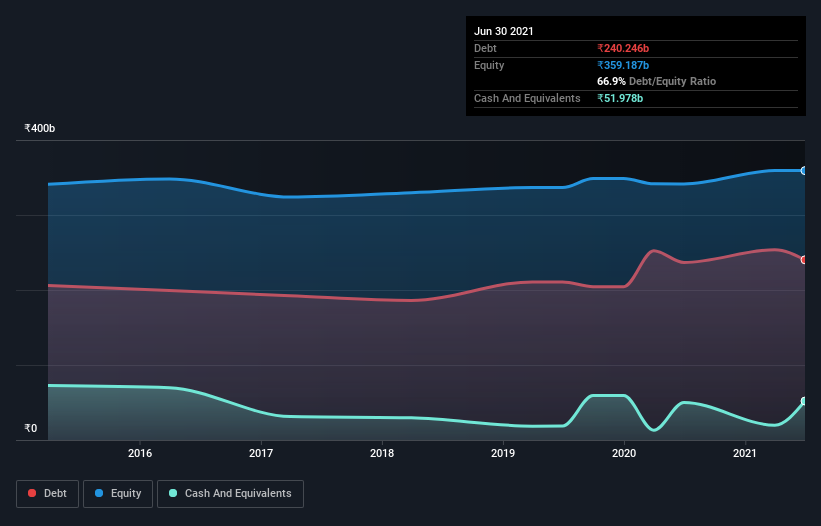
Legendary fund manager Li Lu (who Charlie Munger backed) once said, 'The biggest investment risk is not the volatility of prices, but whether you will suffer a permanent loss of capital.' It's only natural to consider a company's balance sheet when you examine how risky it is, since debt is often involved when a business collapses. Importantly, NHPC Limited (NSE:NHPC) does carry debt. But is this debt a concern to shareholders?
Why Does Debt Bring Risk?
Debt and other liabilities become risky for a business when it cannot easily fulfill those obligations, either with free cash flow or by raising capital at an attractive price. Part and parcel of capitalism is the process of 'creative destruction' where failed businesses are mercilessly liquidated by their bankers. While that is not too common, we often do see indebted companies permanently diluting shareholders because lenders force them to raise capital at a distressed price. Of course, plenty of companies use debt to fund growth, without any negative consequences. The first thing to do when considering how much debt a business uses is to look at its cash and debt together.
See our latest analysis for NHPC
What Is NHPC's Net Debt?
The chart below, which you can click on for greater detail, shows that NHPC had ₹240.2b in debt in March 2021; about the same as the year before. However, it also had ₹52.0b in cash, and so its net debt is ₹188.3b.

A Look At NHPC's Liabilities
The latest balance sheet data shows that NHPC had liabilities of ₹69.6b due within a year, and liabilities of ₹302.8b falling due after that. Offsetting these obligations, it had cash of ₹52.0b as well as receivables valued at ₹64.4b due within 12 months. So it has liabilities totalling ₹256.0b more than its cash and near-term receivables, combined.
This is a mountain of leverage relative to its market capitalization of ₹284.3b. Should its lenders demand that it shore up the balance sheet, shareholders would likely face severe dilution.
We use two main ratios to inform us about debt levels relative to earnings. The first is net debt divided by earnings before interest, tax, depreciation, and amortization (EBITDA), while the second is how many times its earnings before interest and tax (EBIT) covers its interest expense (or its interest cover, for short). Thus we consider debt relative to earnings both with and without depreciation and amortization expenses.
NHPC's debt is 3.6 times its EBITDA, and its EBIT cover its interest expense 6.3 times over. This suggests that while the debt levels are significant, we'd stop short of calling them problematic. We saw NHPC grow its EBIT by 2.1% in the last twelve months. Whilst that hardly knocks our socks off it is a positive when it comes to debt. There's no doubt that we learn most about debt from the balance sheet. But ultimately the future profitability of the business will decide if NHPC can strengthen its balance sheet over time. So if you want to see what the professionals think, you might find this free report on analyst profit forecasts to be interesting.
Finally, while the tax-man may adore accounting profits, lenders only accept cold hard cash. So we always check how much of that EBIT is translated into free cash flow. Looking at the most recent three years, NHPC recorded free cash flow of 47% of its EBIT, which is weaker than we'd expect. That weak cash conversion makes it more difficult to handle indebtedness.
Our View
Both NHPC's level of total liabilities and its net debt to EBITDA were discouraging. But its not so bad at covering its interest expense with its EBIT. When we consider all the factors discussed, it seems to us that NHPC is taking some risks with its use of debt. While that debt can boost returns, we think the company has enough leverage now. When analysing debt levels, the balance sheet is the obvious place to start. But ultimately, every company can contain risks that exist outside of the balance sheet. To that end, you should be aware of the 2 warning signs we've spotted with NHPC .
If you're interested in investing in businesses that can grow profits without the burden of debt, then check out this free list of growing businesses that have net cash on the balance sheet.
Valuation is complex, but we're here to simplify it.
Discover if NHPC might be undervalued or overvalued with our detailed analysis, featuring fair value estimates, potential risks, dividends, insider trades, and its financial condition.
Access Free AnalysisThis article by Simply Wall St is general in nature. We provide commentary based on historical data and analyst forecasts only using an unbiased methodology and our articles are not intended to be financial advice. It does not constitute a recommendation to buy or sell any stock, and does not take account of your objectives, or your financial situation. We aim to bring you long-term focused analysis driven by fundamental data. Note that our analysis may not factor in the latest price-sensitive company announcements or qualitative material. Simply Wall St has no position in any stocks mentioned.
Have feedback on this article? Concerned about the content? Get in touch with us directly. Alternatively, email editorial-team (at) simplywallst.com.
About NSEI:NHPC
NHPC
Engages in the generation, sale, and trading of electricity through hydro, wind, and solar power stations in India.
High growth potential, good value and pays a dividend.
Similar Companies
Market Insights
Community Narratives



